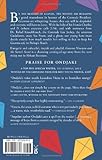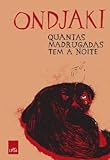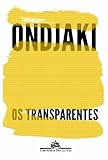Ondjaki’s book, Granma Nineteen and the Soviet’s Secret is an homage to the author’s childhood memories. However, the author does not use childhood memories to settle accounts with his past nor heal his wounds nor is he looking for a catharsis. He uses memory to create a creative and fragrant narrative, perhaps the result of the recurring cups of verbena leaf tea served by his Granma Agnette, the character upon whom the book is based.
The story of Granma Nineteen and the Soviet's Secret emerges from the restlessness of three characters—Charlita, Pinduca (who comes to be known as Pi and later named 3.14 by another character), and the the narrator of the story who is Granma Nineteen’s grandson. However, his name is not revealed in the narrative. It is presumed to be the writer or the consciousness of the whole story meant to unravel the secret of the Soviets which could lead to the destruction of Bishop's Beach, the main setting of the story.
The work interesects two major episodes, one of which is the removal of Granma Nineteen's finger and the other, the secrets of the Soviets. However, the removal of Granma Nineteen’s finger is told in a comedic way and does not create a traumatic situation for the character. This finger extraction takes place in a military hospital where her daughter works as a doctor.
For a reader who might be unaware of the Angolan historical context, it is necessary to pay particular attention to the fact that the doctor is Cuban and opts for the mutilation of Granma Nineteen’s finger. The presence of a Cuban character in the book allows us to situate the story after the Angolan national liberation struggle, where the Angolan regime, under the auspices of the Popular Movement of Liberation of Angola (MPLA), had the help of Cuba. It was in the course of this cooperation that the doctors remained on Angolan soil, providing aid to the regime and its revolutionary project based on popular socialism. Under the Cuban presence there were several urban myths in Angola, mainly in Luanda. These obviously belong to the writer’s childhood memories, and is possibly the reason he introduced one of these myths, albeit subtly, while describing Granma Nineteen’s gangrene and the subsequent removal. Many of these myths were associated with the medical procedures adopted by the Cubans, who purportedly had draconian medical methods, pointing to the idea that it was the Cuban doctors who were responsible for the mutilation of many Angolans.
While the book is grounded in the concrete reality of Luanda, it uses imaginative language and makes strong stylistic choices. For example, the characters do not speak much of the Portuguese adopted by Angolan authorities, and there is an attempt to generate a new vocabulary within the book. Ondjaki’s stylistic statement is not unique to the case of Angolan literature. Since the period of the Angolan National Liberation Front, there has been the affirmation of an Angolan based Portuguese language, i.e., a strong influence of the African languages in the Portuguese language, mainly the Kimbundu language1 belonging to the people of the Northern region of Angola.
José Luandino Vieira was the first Angolan writer to create such a style in Luuanda, a work he developed after discovering the writings of Brazilian author João Guimarães Rosa. Rosa had created a completely new and compelling linguistic universe in the Brazilian literary world grounded on characters from the Brazilian hinterlands.
If, in fact, Vieira absorbed the essence of Rosa’s writings, as he himself recognized in an interview with Michel Laban, stating that, “I hadn’t realized it yet, and that’s precisely what João Guimarães Rosa taught me, he taught me that a writer is free to create a language distinct from the one used by its characters: a homologue of those characters, of their language,” he was certainly a source of inspiration for several writers such as the Mozambican, Mia Couto, and Ondjaki.
However, I would not assert that Ondjaki is a loyal follower of Vieira since both writers’ concerns diverge significantly as well. For instance, Ondjaki’s literary work doesn’t reveal the pressure for affirming a post-independence language unlike Vieira’s, given the fact that the latter was a militant for the MPLA. Vieira was strongly committed to the revolution and to the emerging nationalism in a newly independent country.
Ondjaki, on the other hand, is not burdened by such commitments and certainly not in Granma Nineteen and the Soviet’s Secret. Nevertheless, he has always showed a great interest in his country’s history. The Soviet’s secret mentioned in the book consists of the construction of Agostinho Neto’s Mausoleum, which was initiated in 1981. It is also evident in Onjaki’s use of the word “comrade” when referring to the president, a term that fell into disuse when Angola was no longer under the political orbit of the socialist world.
Ondjaki, just like Vieira, ends up being a predecessor of a new language within Angolan society. This is most evident in his literary works, Granma Nineteen and the Soviet’s Secret (2008), Quantas Madrugadas Tem a Noite (2004), and the most recent one Os Transparentes (2012). The characters make use of words from the outskirts and ghettos of Luanda that are not widely known in the rest of the country.
This Angolan linguistic situation, however, began to be forged during the colonial era though it was not possible for the Angolan writers to disseminate this new language. The cultural hegemony of the Portuguese colonial regime established the Portuguese language as the language of Angola whereby the literary texts were also in accordance with the European linguistic canon. Afterwards, the censorship and propaganda initiated by the State created the idea of Angola as an extension of the Portuguese territory. As such, the Angolan people were forced to speak Portuguese. It was only in this way that the black inhabitants could be considered as assimilated. However, a UNESCO Study on Literacy (1958) showed that “the illiteracy rate among the black African people was 97%., thus only 2% of the black population attended school."2
By the time Vieira started writing about the musseques or the slums of Luanda, he showed that the knowledge of the Portuguese language in those spaces was very narrow. Thus the characters in his books speak a language that is a result of a combining Portuguese and other African languages, particularly Kimbundu.
Ondjaki’s works navigate a sea of childhood memories, and contain references to cowboys and war movies. These types of films were popular in Luanda in the eighties and nineties. However, the most remarkable aspect of the work, in my view, is the transportation of a character created by the great American writer Ernest Hemingway. The old fisherman from the book, The Old Man the Sea, is found in the work of Ondjaki. This shows an attempt to cross two different worlds whereby the author’s imaginary universe goes beyond the realistic universe and opens up newer horizons.
It should be noted that Ondjaki’s literary work is not dense and adopts a minimalist language, and as such is deceptively easy reading. Nevertheless, Ondjaki should not be perceived as a minimalist writer, but rather as a writer whose work depicts a critical view on the complexity of his country. In addition, Ondjaki is an author whose universe is not defined solely by the literature he produces, but also by other spaces since he is an artist, poet, playwright, and a filmmaker.
Endnotes:
1. Linda Heywood’s article “Portuguese into African: The Eighteenth Century Central African Background to Atlantic Creole Cultures” (2002) might shed more light on the subject.
2. PÉLISSIR, René & Wheeler, Douglas, História de Angola,1.ª ed. Lisboa, Edições Tinta-da-China, 2009.
Sérgio Manuel Dundão is currently Professor of Political Science at the Higher Institute of International Relations and Social Sciences (CIS) in Luanda. He completed his Master’s thesis in Lisbon, Portugal at the Faculty of Social Sciences and Humanities of the New University of Lisbon(Faculdade de Ciências Sociais e Humanas da Universidade Nova de Lisboa) and his dissertation was titled Armed Conflict and State Building: A Comparison between Angola, Mozambique and Guinea-Bissau.





